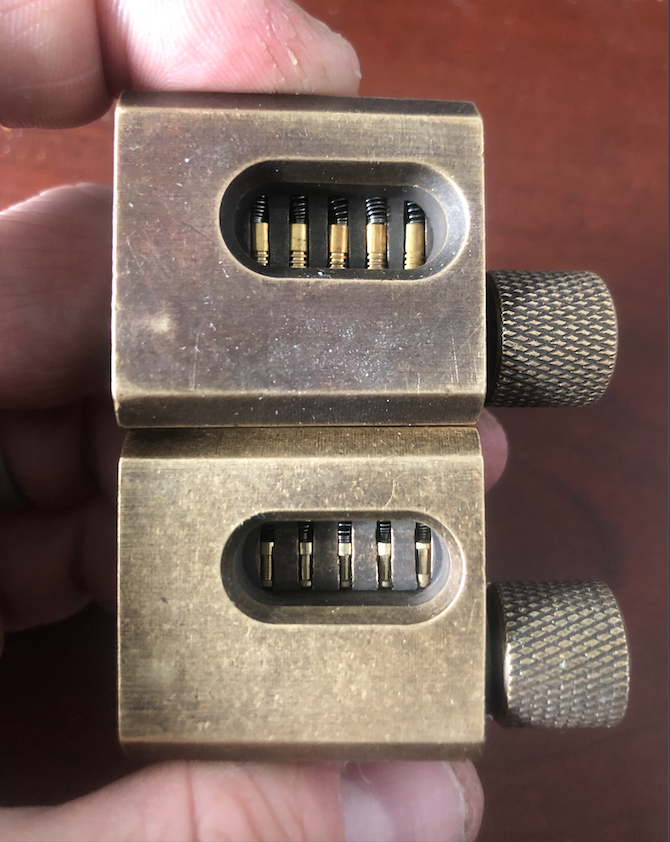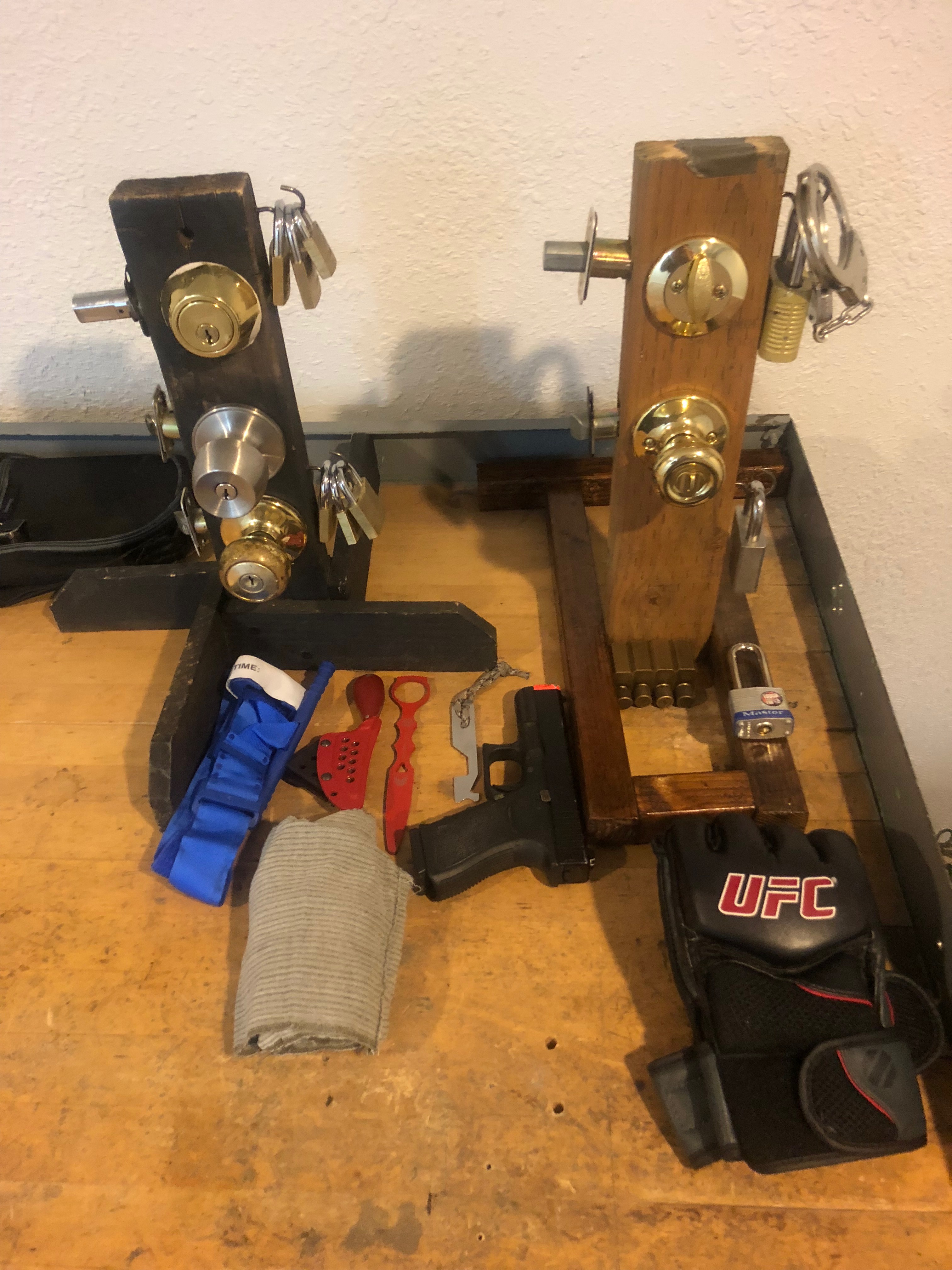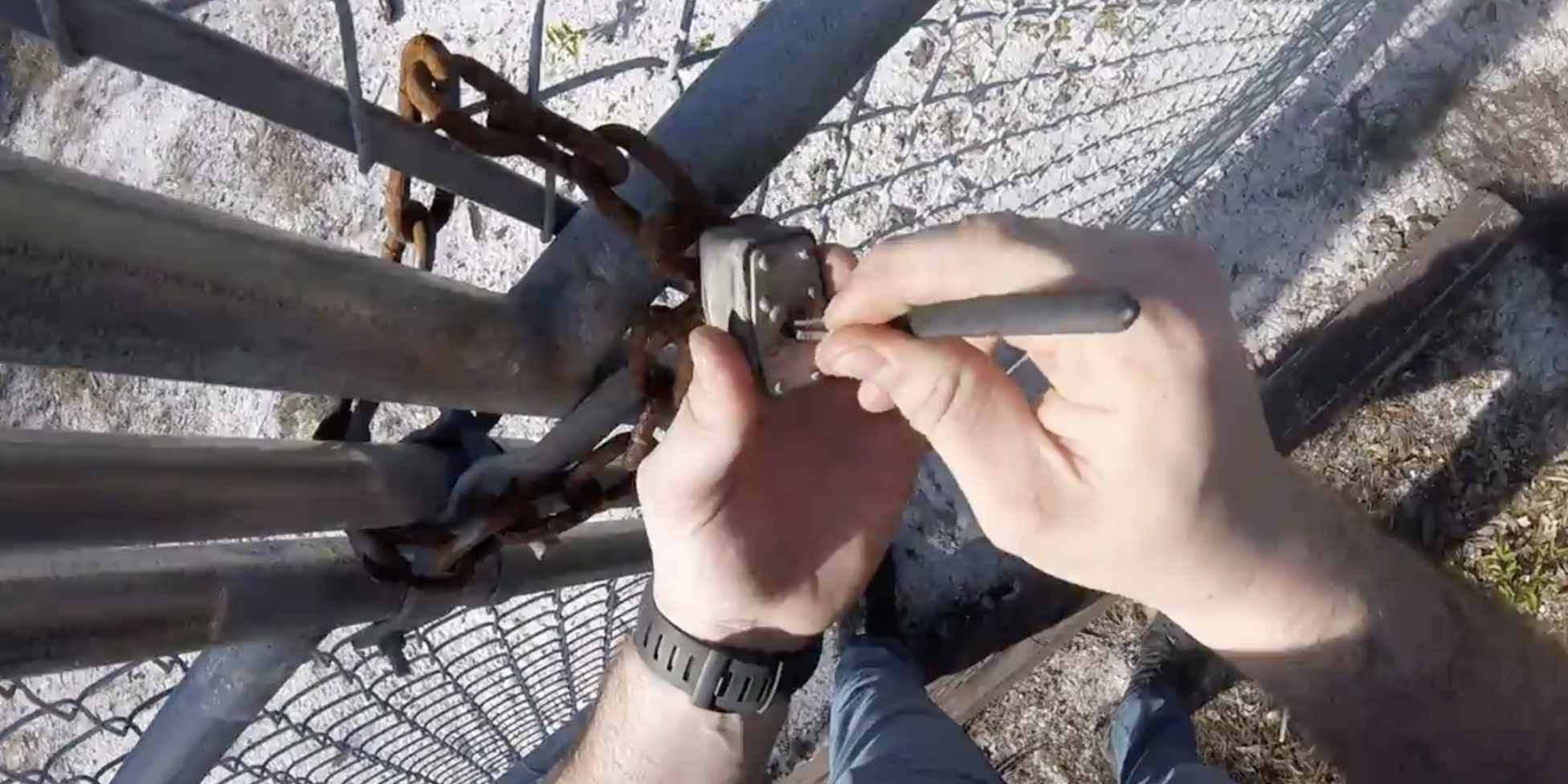When discretion matters, knowing how to defeat security without leaving a trail of destruction is invaluable. Join us as we discuss defeating physical security.
Introduction
“Locks only stop honest people.”
My father told me that ages ago and it’s true. The idea behind most modern security is to slow down potential thieves, keep them scouting for easier targets, or disallow them access to your valuables.
In Spheres of Violence, we talk about how weapons-based skills don’t cross cleanly between different professions. With lockpicking, we have a universally important, useful, and time-saving tool that, when employed by people who have some ethics, can be helpful whether you’re exploring or locked out of your hotel room. So what do we mean by non-destructive bypass?
We mean developing skills necessary to get past padlocks, door locks and deadbolts, and vehicle locks without destroying the locking mechanism or some other element of security. We focus on these types of locks because typically, these are the common points people lock themselves out of and have to call a locksmith. If you’re a thief (or you’re in a serious emergency), it’s far easier to just break stuff. Non-destructive entry in general means you care enough to not break the lock.
So as we’ll see, locks don’t even stop honest people anymore.
The Lobby: Ethics and Practicality
Our entire culture at ISG is based around things that are inherently dangerous; from rappelling to shooting guns, we find that the difficult skills are the ones most worth pursuing. With them comes responsibility. So while we agree with many of our peers that certain skills should be kept ‘private’, we want to skim the surface of security bypass. This means we’re putting our trust in you that you’ll follow the applicable laws… and more importantly, that you’ll use these skills ethically.
So here’s what we’d like to ask in return:
Please don’t steal. Don’t pick a lock without permission. Don’t use these skills to trespass. Know your laws in your area regarding possession of lock picks.
We’re presenting information on this topic knowing that laws don’t stop dishonest people and robbing good people of information only makes them more vulnerable.
With the ethics disclaimer out of the way, there’s still a feeling of revulsion in a lot of people when we discuss bypassing security. Often, people reflexively ask “why would you need this?” or worse “why would you teach this?”
The answer is manifold:
- We can’t teach it. It’s experiential. Bypassing security requires hours and hours of dedicated practice beyond instruction.
- This information isn’t ‘state secret’. It’s all available commercially or free from media sharing platforms.
- Understanding how to bypass security leads to a greater knowledge of how to secure your valuables.
- Bypassing security can sometimes be necessary – such as when you’re locked out of your home, vehicle, or lose keys to padlocks, etc.
- Illegal restraint is a real thing. Especially for children and young women, some ability to recognize threats and some basic escape and evasion skills go a long way.
There’s nothing inherently wrong with being able to defeat security. Like many of our other skills, when you can pick locks, you’ll find that you’re a lot less reliant on others and that your friends and co-workers appreciate it when you can help them out.
Ground Floor: Tools

Your security is only as good as your weakest point.
Training for security bypass can start pretty simply: Got an extra lock with no key? Start a box. Changing out locks on your house? Keep the old ones and build a lock tower.
As for what picks to start with, there are tons of options and as with anything, what you get will start with asking “what do you want to do?” With that said, here are some of the kits and tools that the ISG team has used to great effect while out and about:
Bogotá Entry Toolset: A simple, durable, and effective toolset, the Bogotá provides a lightweight option with a limited magnetic signature. The Picks themselves each serve as a tension wrench, and feature a probe and rake that are good enough for most types of locks. The Bogotá tools have been a constant companion for 9 years now, having traveled most of the U.S. and overseas with the author. While they’ll handle most jobs, for high security locks, those that require top-of-keyway (TOK) picking, or those with very narrow keyways, they just won’t do.
Sparrow’s Creeper Toolset: The Creeper picks up where the Bogotá’s leave off. They offer more tools in more sizes to address the less common high security locks. ISG Team members view the Creeper Toolset as a ‘standard’ piece of EDC for those with some skill and interest in lock picking.
ISG MMD Wallet/Rare Element Toolset: These sets are part of a limited edition partnership between ISG, Manly Man Designs and Rare Element to create a truly ‘everyday’ wallet that discreetly holds a high-quality, minimalist pickset with the essential tools; a Crows Foot triple peak rake and Hybrid probe, along with several options for torsion tools to give a variety of options for torsion, single pin picking, and raking.
Plug Spinner: The plug spinner is a tool of convenience. On some residential locks, you can pick the incorrect way leading to cylinder release, but no actuation of the lock itself. That means you picked it, but the lock isn’t going to budge. A plug spinner can save you the hassle of picking it again by rotating the cylinder so fast that the pins don’t have a chance to reset. While good picking technique is preferable, the plug spinner can save you some serious time. We have a video on it here, but fair warning… it’s old.
Situations

The normal first response when people learn you are able to pick locks is that you’re either a criminal or spooky. When I tell people that of all the skills I’ve cultivated over the years, lock picking comes in handy more than any other, there’s almost always a non-committal “huh” and shrug. The truth is that bypassing locks is not only useful for criminals and special operators. There’s a practical element to it that can help you save time, money, and generally be more efficient.
Let’s be up front though: for disaster management, picking locks is one of the least expedient methods possible. Unless you’re a pro, destructive bypass is usually much faster.
With that said, we often times want to get into places without leaving a trail of broken stuff… A person who can get to an intermediate level of skill with raking and single pin picking can expect they’ll be able to get in to most low security padlocks and safes, and residential doors.
As this this series progresses, we’ll discuss the role of security bypass in emergencies, but for now, it’s as simple as this: People get accidentally locked out of things all the time.
It used to happen to us, too.
A word of caution: if you’re in an emergency situation, non-destructive methods take a long time. Each lock is different and it takes time to learn them. Cultivating some picking skills is great, but don’t expect that you’ll be able to step to any lock you encounter in the field and pick it. The lock’s condition, age, security rating, how its mounted, the light conditions… all these things conspire to keep you out.
How it works

Lockpick Types
There are a variety of different picks that can be used to open locks, but here’s a very sensible set that will work for the majority of the locks you’ll encounter:
- Bogotá (3 hump) or Triple Peak: The Triple Peak works well for 6 pin padlocks without security pins.
- Bogotá (2 hump) or Twin Peak: These (often referred to as Bogotás) rakes are one of the best ‘general purpose” rakes out there. Frequently used for padlocks or low security residential doors, they’ll also work well on certain canopies and deadbolts.
- Worm Rake: A little more gradual than the Bogotá, the worm rake can be used with slightly smaller keyways, but still works well on standard sized locks.
- City Rake: The City Rake is called such for the ‘cityscape’ profile. It’s less for raking, and more for setting in the key and ‘see-sawing’, which can be useful for certain types of locks (padlocks, mostly).
- Short Hook or Probe: Probes are the tools with which we feel around to determine the number of pins, their setting order, and how we lift them into place when single-pin-picking (SPP). The probe is a tool for more difficult locks with security pins that defeat attempts at raking or scrubbing (discussed below).
- Offset Hybrid or Offset Half Diamond: These probes are good for smaller locks that require a bit more delicacy. Often, these tools are paired with a Top of Keyway tension wrench in order to free up space in the keyway.
- Torsion (or tension) Bar: This device allows us to rotate the cylinder slightly while setting the pins inside the lock. Torsion (rotational tension) is the first technical aspect of picking to pay attention to; over-applying torsion is a common cause of keyway binding. Imagine light pressure would be such that if you were applying your finger to a needle, you wouldn’t draw blood. Heavy pressure would be about as much as it takes to press a key on a keyboard.
Wider, more rigid wrenches will give you more ‘feedback’ and control when picking locks than thinner, springier wrenches.
- Flat Bar Torsion Bar: These are applied with in one of two main spots: ‘Bottom of Keyway‘ (BOK) or ‘Top of Keyway‘ (TOK).
- 0.40″ Dog Ear Flat Bar: These smaller width flat bars are made for applying torsion to the top of keyway on higher security locks with recessed cylinders; this means that the body of the lock protrudes past the keyway, making it harder to get a standard torsion tool in there.


Anatomy and Mental Mapping
The basic pin tumbler lock is something that should be understood in order to be defeated. High level pickers talk about “mentally mapping” the lock. It’s really easy to over look the importance of this because:
- It’s difficult, and;
- It’s easy to convince ourselves we can just rake our way through easy locks
When you start to encounter difficult locks in which single pin picking (SPP) is required, you’ll have cheated yourself if you’ve not spent any time working on understanding what’s happing inside the pin tumbler lock.
What we’re looking for when we’re mentally mapping a lock is:
- Cylinder Rotation/Counterrotation as we ‘set’ pins. This rotation can mean a few things, but it’s mainly important because it tells us we’re dealing with a security pin. Because security pins are “cut” in the middle, the taper allows the pin to ‘wobble’, which tells us it’s trying to straighten itself.
- The Binding Order in which the pins will need to be picked. Each pin has a “driver” and “set” pin. The driver pin needs to be set at the shear line before the set pins can freely rotate. Because the channels in which the pins sit aren’t all in a perfectly straight line, when you try and rotate the cylinder, pins will encounter resistance in a different order. The first pin to hit is the first pin that must be picked. This topic was covered brilliantly by “Art of Lockpicking”, so we’ll refer you to their article on “binding order“, as they’ve got quality images, illustrations, and writing on the topic.
Techniques for Picking Locks

Locks can be picked by a few different methods, but the most common types are:
- Raking: Raking is the process of randomly popping the pins up and down while applying tension (or torsion) to the keyway. Raking works well for low-security locks without security pins. An excellent video resource can be found here.
- Single Pin Picking: This is the process of selecting pins in a sequence, setting them to the cylinder’s sheer line, and unlocking the lock using deliberate technique. This is required for higher security locks, as raking generally won’t work as well when security pins are present.
- Rakewalking/scrubbing: This technique takes a hook, probe, or half diamond to strum the pins while applying some light torsion. On some locks, this can work like raking.
Problems

- Security Pins: Security pins are a feature that makes it more difficult to set individual pins in place, especially against raking. Though it’s possible to rake security pins, it often requires us to stop and single-pin pick the lock. Security pins typically use a spool or serrated pins that will create false sets or binds. Interrogating a lock for spool/serrated pins usually means determining the binding order, and probing the pin until you’re able to find and set it correctly.
- Over-set Pins: If you refer to the picture above (999 key and cylinder nomenclature), you’ll see that there are two color pins: Green and Gray. The Green pins. The Gray are called “Driver Pins” and the green are called “Key Pins“. Overset occurs when the key pin passes the shear line of the cylinder. In order to open the lock, you’ll need to drop the key pin back below the shear line… but not so much so that the driver pin has a chance to snag.
- False set – False set occurs when a security pin feels like it’s in place and has been picked. Generally, this occurs when a security pin like a spool pin has been set incorrectly.
- Torsion (rotational application force) is often mistaken from Tension (linear application of force). Whatever you call it, one of the most common problems with picking locks is “monkeying” the torsion… This happens when the impulse to use force overwhelms technique. There’s are some really great resources on lock picking out there, and we’ll paraphrase some of the instructors who’ve mentored us: heavy pressure on the torsion wrench should be no more than what it takes to depress a keyboard key. Light pressure would be so little that if your finger was pressed against a thumbtack, you wouldn’t puncture the skin. With that said, you should go in to each lock ready for them to be heavier than expected. Especially bulky, medium and high security locks, which often require much more torsion that others.
Training

As a part of your training in defeating locks using non-destructive methods, it can be helpful to make some basic training aids. If you’re interested in a DIY project, consider building a Lock Tower. That will only get you so far, so also look into what Sparrow’s offers; they have basic practice locks, as well as security cut-away locks for spool pins, and serrated pins.
These can be great assets in learning how to work your locks and refine your technique, from beginning to advance.
Likewise, it’s best to focus on practice when you train for non-destructive bypass; don’t watch TV and try and pick locks. You’ll find distractions cause you to tune out the subtle sounds and feels of learning a lock. Once you’ve got a lock down, sure. By when you’re first learning, truly set aside some time to mentally map and methodically pick the lock. If you find that you can’t, set it aside and return to some easier locks to stay in practice.
Picking is *extremely perishable*. If you don’t keep up on it, don’t expect you’ll be able to bypass any lock you encounter. Locks out there in life are always more difficult, and weathering, age, grit, and orientation all make field picking more challenging.
Conclusion
We hope you’ve found this to be a useful and informative primer that both emphasizes the practicality and highlights the tools and techniques necessary for non-destructive bypass. As we’ve discussed earlier, please use this knowledge responsibly, as we’re not responsible for misuse.
Like most of our skills at ISG, a tremendous amount of time can be spent developing your picking skills and they’re very perishable. If you plan to build the skill, plan to maintain it periodically as well.
As always, if you’ve found this interesting or useful, we hope you’ll share it with your friends. Your support keeps us alive.
Cheers,
ISG Team
Shout out to Patron Chris for encouraging us to write this primer. We hope it meets your expectations, and provides good information that you can use over and over again.








